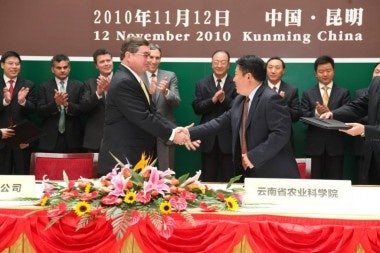Coffee Giant Bought Back Full Ownership Of 250 Locations In Five Provinces#

Starbucks will nearly triple its China locations in the next four years (Image: China Daily)
Anyone who has set foot in China's larger cities over the past five years has undoubtedly noticed the growing presence of Starbucks, which has exploded from its first mainland China location in 1999 to 450 today. Over the past few years in particular, as the company has dealt with the overexpansion-fueled crisis in its home market that saw it close hundreds of locations in the wake of the global economic crisis, Starbucks has turned to China as its "second home market." Looking to leave its ever-increasing domestic and international competitors in the dust, Starbucks has spent the last two years in China expanding into relatively untapped third-tier cities, working with the Yunnan provincial government to develop the region's nascent coffee industry, and taking on once-dominant brands like Nescafe with its Via instant coffee. Now, as part of its latest bid for coffee primacy in China, Starbucks has taken a page straight out of the playbook of high-end brands like Burberry and has bought back full control of stores from a Chinese joint-venture partner.
Last week, Starbucks signed an agreement with Maxim’s Caterers Ltd., its partner in south China (including Macau and Hong Kong), to assume control of its locations in the provinces of Guangdong, Hainan, Sichuan, Shaanxi and Hubei, as well as the municipality of Chongqing. As Starbucks president John Culver said, the moves are designed to "accelerate growth as we look to achieve our goal of having 1,500 stores across [China] by 2015." As the Wall Street Journal added, the deal between Starbucks and Maxim's reflects the primary focus placed on mainland China by Starbucks, as Maxim's will now assume full control of 110 Starbucks locations in Hong Kong.
So, with full responsibility for more than half of its mainland China locations, what shape will Starbucks' new strategy take in south China? Presumably, it will follow the lead of Burberry and focus not only on opening new locations, but will also place priority on enhancing brand experience and customer service. As Jing Daily wrote last summer, after Burberry "burned bridges" with its former joint-venture partner Kwok Hang Holdings, global brands that are in a rush to capitalize on China's fast-growing consumer market are at risk of spreading themselves too thin. This is particularly true for brands relying on joint-venture partners to manage expansion, as Beijing Business Today suggested:
Industry experts feel that luxury brands taking control of and supervising daily store operations will improve the level of service of staff in retail locations, which will mean consumers will finally be able to enjoy the high level of service fitting of a luxury brand.
From an insider’s point of view, if a brand’s most coveted goal is brand image, if agents simply undertake store expansion in the pursuit of greater profits, brand image will be hurt. Agents may not match the brand’s standards of operations management or HR, which too will tarnish the brand image. Direct management of brands doesn’t only ensure a steady rate of expansion, but also balances the relationship between rapid expansion and store management.

Starbucks announced its Yunnan Province "Farmer Support Center" initiative last fall
As a far more affordable "luxury" for the Chinese middle class, and a player in a very crowded field now populated by rivals like Costa Coffee, Juan Valdez, UCC, Pacific Coffee and many others, Starbucks is facing very different challenges in China than fashion brands like Burberry. But its strategy of consolidating control of its mainland China operations to ensure a consistent brand image throughout the country (while trusting JV partner Maxim's ability to manage its Hong Kong operations) and more smoothly roll out localized products and marketing efforts in south China follows the same lines. Considering the success that Burberry has seen in mainland China since buying back control from Kwok Hang Holdings last year, it's not surprising that other companies are now looking to more directly manage their expansion and keep tabs on brand image.
Having established the fact that Starbucks will more than triple its mainland China locations in the next four years, the somewhat ironic question remains: How will the company entice more Chinese to drink more coffee? As Morgan Stanley analyst John Glass recently told the Wall Street Journal, single-store sales in China's Starbucks are on average 40% less than in the United States. Could Starbucks' instant coffee imprint Via, which hit the China market in March, prove a winning factor among convenience-minded Chinese office workers? Or will the company find it has to localize this line to take on its much cheaper and more entrenched rival Nescafe, which popularized the "three-in-one" (coffee/sugar/creamer) single-serving packet in China? As Huang Mao, a beverage analyst with Guosen Securities, told the Global Times last week, to take on its local rivals in China, the key for Starbucks "is to occupy niche markets and expand the product line." With its instant coffee line, Starbucks is doing both. But will it be enough to get more Chinese customers to line up for a daily caffeine fix?